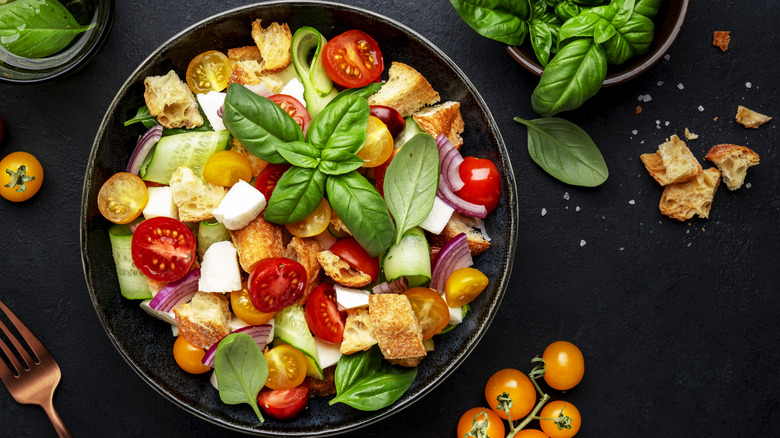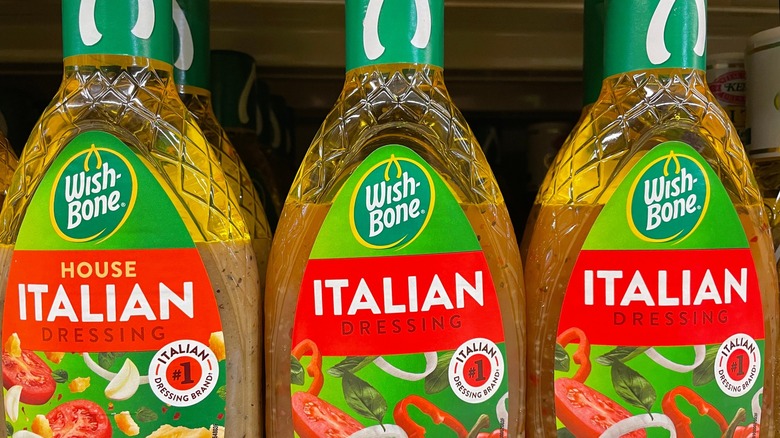The Common Type Of Salad Dressing Tourists Visiting Italy Will Look Foolish Asking For
Spaghetti with meatballs, pepperoni pizza, and cheesy garlic bread are a few Italian American staples that some tourists might think are as ubiquitous in Italy as they are everywhere else. Alas, that is not the case. When it comes to culinary missteps in Italy, there's one more you can add to the list: the futile quest for Italian dressing. This might lead to confused looks, a couple of "che cosa" hand gestures, and gentle corrections from the local waitstaff. Understanding the origin of this dressing and why it's virtually non-existent in traditional Italian cuisine can save visitors from committing a dining faux pas and enrich their cultural and culinary experiences while in Italy.
Italian dressing is a vinaigrette-type salad dressing made from a concoction of olive oil, vinegar, lemon, garlic, chopped bell peppers, often a sweetener, and various herbs and spices, such as oregano and basil. It is popularly used on salads or as a marinade for its robust and tangy flavor. This dressing, however, is not Italian in origin but American. Legend has it that Italian dressing was created in 1948 by Phillip Sollomi at his Kansas City restaurant, the Wishbone. The dressing, based on a Sicilian recipe brought by Sollomi's mother, gained popularity, leading to its commercial bottling. Around the same time, Ken Hanna of Ken's Steak House in Framingham, Massachusetts, was also concocting an Italian dressing based on a family recipe from Genoa, which cemented the restaurant as a salad pilgrimage site to this day.
Italian salad dressings: a different reality
The concept of a single "Italian dressing" does not exist in Italy. Instead, salads are typically dressed very simply with what many call "olio e aceto," which translates to oil and vinegar. The oil is almost invariably extra virgin olive oil, prized for its health benefits and flavor. The vinegar is usually red wine vinegar, balsamic vinegar, or sometimes simply lemon juice. This dressing is seasoned with some salt and perhaps a pinch of pepper — no herbs, no garlic powder, and certainly no sugar or bell peppers. Masking the flavor of the vegetables in the salad with an "artificial" dressing would be sacrilege — instead, it can be enhanced by high-quality oils and vinegar.
Each Italian region might add a local touch to how they dress their salads. For example, in Modena or Reggio Emilia, the proverbial capitals of vinegar, a drizzle of traditional, Protected Designation of Origin (DOP) balsamic might replace the more common red wine vinegar. In coastal regions, a squeeze of lemon for acidity might be more prevalent, reflecting the citrus groves common in areas like the Amalfi Coast. However, across all of Italy, "dressing" is not a noun but a verb. A famous Italian proverb states, "To properly dress a salad, you need a miser to add the vinegar, a judge to add the salt, and a spendthrift to add the oil." That's a tiny splash of vinegar, the perfect balance of salt, and a most generous heaping of olive oil.
Addressing the salad dressing culinary faux pas
So, what happens when a tourist asks for Italian dressing? If you're dining in a tourist area right across the Colosseum or the Leaning Tower of Pisa, you might be able to score some type of "international" dressing at a typical tourist-trap restaurant (most likely Caesar salad dressing). Otherwise, if you are in a traditional Italian restaurant, the server will try to accommodate the request by offering olive oil and vinegar, the closest available option. More often than not it will lead to the explanation that such a product doesn't exist in Italy. For Italians, the very concept of a standardized bottled dressing with a fixed recipe goes against the grain of their culinary culture, which celebrates freshness, regional variations, and simplicity.
For those planning a trip to Italy, embracing local dining customs can lead to a more authentic and enjoyable experience. It's an opportunity to explore the nuances of one of the world's most well-known (yet misrepresented) cuisines, one that is deeply regional and tied to the landscape and the seasons. Instead of looking for the familiar on the menu, ask the waiter for local recommendations and explore different specialties, including how salads are dressed. As much as you may love "Italian" dressing, it's best to leave it behind — unless you can find a travel-size TSA-approved bottle of it (although bringing that to a traditional Italian restaurant will require some formidable, despicable gusto and may or may not get you royally shamed).


